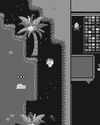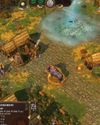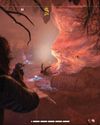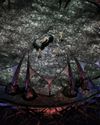
I don’t know much about astrophysics, aerodynamics, or anything else to do with rocket science, but I do know how to tell when someone is trying very hard to avoid saying the words ‘kerbal orgy’. New studio Intercept, which has taken the reins on KSP, is busy crafting a sequel, coming next year, that includes intergalactic travel, multiplayer and helpful tutorials for science-challenged players like me. Reading between the lines of my first look at Kerbal Space Program 2, the kerbals themselves are getting busy too.
Over the course of two days I spoke with the dev team about what’s new in Kerbal Space Program 2, what’s changed, and just as importantly what’s not changed, to preserve the wonderful sense of accomplishment and discovery that defined one of PC gaming’s greatest experiences. At no point did anyone say these little green explorers are so excited about intergalactic travel that they throw a spontaneous space orgy, but I’m here to tell you it’s most definitely happening.
And honestly, I’m thrilled about it. It’s hard, lonely work going where no kerbal has gone before, and they deserve to celebrate – especially because that sweet, sweet space nooky is a key part of Kerbal Space Program 2’s vastly expanded progression into the unknown.
THE BIG BOOM
Ext: Space. The camera pans across a desert landscape, the faint flow of starlight refracting through a layer of atmosphere at the horizon. Stirring synth chords and a bass drum aren’t quite reproducing Also sprach Zarathustra, but the tone is the same. Mysterious. Ominous? The vibe is unmistakably 2001.
This story is from the {{IssueName}} edition of {{MagazineName}}.
Start your 7-day Magzter GOLD free trial to access thousands of curated premium stories, and 9,000+ magazines and newspapers.
Already a subscriber ? Sign In
This story is from the {{IssueName}} edition of {{MagazineName}}.
Start your 7-day Magzter GOLD free trial to access thousands of curated premium stories, and 9,000+ magazines and newspapers.
Already a subscriber? Sign In

A New Dawn - The rise, fall and rise again of PC Gaming in Japan
The so-called 'Paso Kon' market (ie katakana's transliteration of 'Pasonaru Computa') in Japan was originally spearheaded in the 1980s by NEC's PC-8800 and, later, its PC-9800.

MARVEL: ULTIMATE ALLIANCE
Enter the multiverse of modness.

SLIDES RULE
Redeeming a hated puzzle mechanic with SLIDER

GODS AND MONSTERS
AGE OF MYTHOLOGY: RETOLD modernises a classic RTS with care

PHANTOM BLADE ZERO
Less Sekiro, more Wo Long: Fallen Dynasty

STARR-MAKING ROLE
Final Fantasy XVI's BEN STARR talks becoming a meme and dating summons

THIEF GOLD
Learning to forgive myself for knocking out every single guard.

HANDHELD GAMING PCs
In lieu of more powerful processors, handhelds are getting weirder

FAR FAR AWAY
STAR WARS OUTLAWS succeeds at the little things, but not much else shines

FINDING IMMORTALITY
Twenty-five years on, PLANESCAPE: TORMENT is still one of the most talked-about RPGs of all time. This is the story of how it was created as a ‘stay-busy’ project by a small team at Black Isle Studios